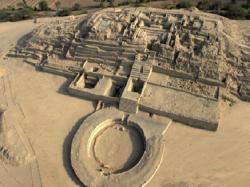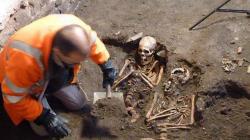INSTITUT SUPERIEUR D'ANTHROPOLOGIE
INSTITUTE OF ANTHROPOLOGY
ONLINE COURSES / COURS A DISTANCE
SPRING TERM : APRIL 2014
REGISTER NOW
PEROU –  Murco - Experts in the Valle del Colca area of Peru have restored a number of religious figurines that dated back the the 17th and 18th centuries. According to Andina news agency, the figurines came from the Murco church in Caylloma provinces of the region of Arequipa. Andina reports that the collection included statues depicting Jesus, the Virgin Mary, St. Joseph, as well as other important religious and historical figures. Carrión also told Andina that the restoration took several months and was carried out by professionals trained in Escuela Taller Colca with support from the Spanish Agency for International Cooperation and Development (AECID). The cultural organization’s next project will be to restore paintings from churches in Tisco and Sibayo that date back to the 1600s and 1700s. Workers are also performing maintenance duties on the historical church building in Sibayo.
Murco - Experts in the Valle del Colca area of Peru have restored a number of religious figurines that dated back the the 17th and 18th centuries. According to Andina news agency, the figurines came from the Murco church in Caylloma provinces of the region of Arequipa. Andina reports that the collection included statues depicting Jesus, the Virgin Mary, St. Joseph, as well as other important religious and historical figures. Carrión also told Andina that the restoration took several months and was carried out by professionals trained in Escuela Taller Colca with support from the Spanish Agency for International Cooperation and Development (AECID). The cultural organization’s next project will be to restore paintings from churches in Tisco and Sibayo that date back to the 1600s and 1700s. Workers are also performing maintenance duties on the historical church building in Sibayo.
http://www.peruthisweek.com/news-experts-restore-religious-artifacts-from-perus-colca-valley-102071
USA –  Tennessee - There are more than 100 caves and rock sites in Tennessee that reveal forms of prehistoric art, and University of Tennessee archaeologist Jan Simek says he plans to find many others.Simek, a distinguished professor of science at the University of Tennessee in Knoxville, and a team of archaeologists in recent years have made several new cave and rock art discoveries in the Cumberland Plateau, the Smoky Mountains and the river valley in East Tennessee. Some pictographs are underground and others in the open air, many dating back 6,000 years.The rock art is religious iconography and portrays how people may have viewed the universe within three layers: the upper world; the middle world, where humans live; and the lower world, he said. Paintings that illustrated the upper world are painted high above the ground on bluffs, for example.
Tennessee - There are more than 100 caves and rock sites in Tennessee that reveal forms of prehistoric art, and University of Tennessee archaeologist Jan Simek says he plans to find many others.Simek, a distinguished professor of science at the University of Tennessee in Knoxville, and a team of archaeologists in recent years have made several new cave and rock art discoveries in the Cumberland Plateau, the Smoky Mountains and the river valley in East Tennessee. Some pictographs are underground and others in the open air, many dating back 6,000 years.The rock art is religious iconography and portrays how people may have viewed the universe within three layers: the upper world; the middle world, where humans live; and the lower world, he said. Paintings that illustrated the upper world are painted high above the ground on bluffs, for example.
http://www.tennessean.com/article/20140126/NEWS01/301260078/TN-cave-rock-art-offers-prehistoric-perspectives?nclick_check=1
PORTUGAL –  Loulé -Archaeologist Alexandra Pires has revealed that the bathing complex consists not only of hot, tepid and cold bathing rooms, but that the most recent discoveries have extended to reveal cold water tanks, latrines and patio areas dating back over a thousand years.
Loulé -Archaeologist Alexandra Pires has revealed that the bathing complex consists not only of hot, tepid and cold bathing rooms, but that the most recent discoveries have extended to reveal cold water tanks, latrines and patio areas dating back over a thousand years.
Alexandra Pires explained how the archaeological discovery came about after the area was excavated to install a rainwater catchment tank but thanks to the discovery the tank will now have to be located in a new site. The site of the public baths is currently being protected from the elements but the local Câmara have stated that they have plans to develop the area into a historical tourist attraction in the future. Pires added that while the bathing complex was not as well preserved as some that can be found in Spain, that the Loulé complex stood out as as an historical landmark because of its location at the entrance to the city rather than within city grounds as with other examples in Iberia.
http://theportugalnews.com/news/important-archeological-discovery-in-loule/30448
ROYAUME UNI –  Ilkley - An archaeological dig aims to uncover new information about Ilkley’s ancient Roman fort and the lives of the soldiers who once lived there. Archaeologists are digging trial trenches on Castle Hill - close to the Manor House Museum and All Saints Parish Church.The history of the Roman fort at Ilkley - said by some to be named Olicana - is based largely on early 20th Century excavations in the north-western quadrant and a single trench through the defences excavated in 1962. The fort is thought to have been established in the late first century AD, on a knoll overlooking the River Wharfe, as part of the Governor Agricola’s campaigns of conquest in the Pennine region.
Ilkley - An archaeological dig aims to uncover new information about Ilkley’s ancient Roman fort and the lives of the soldiers who once lived there. Archaeologists are digging trial trenches on Castle Hill - close to the Manor House Museum and All Saints Parish Church.The history of the Roman fort at Ilkley - said by some to be named Olicana - is based largely on early 20th Century excavations in the north-western quadrant and a single trench through the defences excavated in 1962. The fort is thought to have been established in the late first century AD, on a knoll overlooking the River Wharfe, as part of the Governor Agricola’s campaigns of conquest in the Pennine region.
http://www.thetelegraphandargus.co.uk/news/local/ilkleynews/10955965.New_excavations_take_place_at_Ilkley_s_Roman_fort/?ref=rss
FRANCE –  Saint-Philbert- de-Grand-Lieu - Les fouilles réalisées au nord de l'abbatiale de Saint-Philbert- de-Grand-Lieu vont permettre aux chercheurs d'avancer. Quelques semaines après la découverte archéologique d'un ensemble de sépultures au nord de l'abbatiale de Saint-Philbert-de-Grand-Lieu, les résultats des datations de deux d'entre elles au carbone 14 montrent qu'elles sont bien du Moyen Âge. « La période d'ensevelissement est bien antérieure au XVIe siècle, confirme Mathilde Angelvy, directrice du service culturel de la ville. L'un des adultes découverts a été enterré au XVe siècle ; l'autre sépulture analysée témoigne d'un usage de cet espace en cimetière, il y a au moins 800 ans (fin XIIe siècle) ! »,,Les études en centre de recherches des informations prélevées sur le terrain vont se poursuivre pour proposer de premiers éléments d'interprétation sur les usages et aménagements, passés, de l'espace concerné. « C'est sur ces bases que les chercheurs pourront élaborer un nouveau projet scientifique, à la hauteur de ces découvertes, explique la directrice, mais aussi et surtout, du potentiel d'informations contenues dans ces « archives du sol » qui semblent encore en place sous les premières fosses d'inhumation dégagées. »
Saint-Philbert- de-Grand-Lieu - Les fouilles réalisées au nord de l'abbatiale de Saint-Philbert- de-Grand-Lieu vont permettre aux chercheurs d'avancer. Quelques semaines après la découverte archéologique d'un ensemble de sépultures au nord de l'abbatiale de Saint-Philbert-de-Grand-Lieu, les résultats des datations de deux d'entre elles au carbone 14 montrent qu'elles sont bien du Moyen Âge. « La période d'ensevelissement est bien antérieure au XVIe siècle, confirme Mathilde Angelvy, directrice du service culturel de la ville. L'un des adultes découverts a été enterré au XVe siècle ; l'autre sépulture analysée témoigne d'un usage de cet espace en cimetière, il y a au moins 800 ans (fin XIIe siècle) ! »,,Les études en centre de recherches des informations prélevées sur le terrain vont se poursuivre pour proposer de premiers éléments d'interprétation sur les usages et aménagements, passés, de l'espace concerné. « C'est sur ces bases que les chercheurs pourront élaborer un nouveau projet scientifique, à la hauteur de ces découvertes, explique la directrice, mais aussi et surtout, du potentiel d'informations contenues dans ces « archives du sol » qui semblent encore en place sous les premières fosses d'inhumation dégagées. »
http://www.ouest-france.fr/les-sepultures-datent-du-moyen-age-1882748